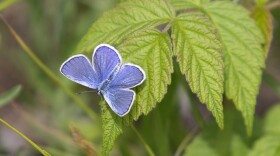The Albany Pine Bush Preserve is a unique and important habitat for several native species.
On a cool summer morning, as the sun rises over the barrens, some volunteers are among the brush removing birds from several hanging nets. The birds are being collected so they can be fitted with a small metal band. Albany Pine Bush Preserve Conservation Director Neil Gifford says the bands are provided by the U.S. Geological Survey’s Bird Banding Library.
“Every bird gets a unique, numbered band. So anybody that ever catches this bird again will be able to pull up our data,” says Gifford.
Inside a tent, Gifford removes the birds brought in by volunteers from soft cloth bags.
He cradles a small Gray Catbird, a species that gets its name from its familiar call. This one, with shaggier feathers, is a baby.
“Probably not out of the nest more than a week or so,” says Gifford.
Gifford looks up the birds on a handy chart, and each is fitted with a band. With the help of volunteer Jane Tatlock, data is recorded – species, approximate age, weight, etc.
It takes a few minutes, and then the birds are released.
Another bird Gifford examines is a small olive-and-yellow warbler called a Common Yellowthroat.
“So this is more of a generalist shrubland bird, much like the Grey Catbird. You can find Common Yellowthroats almost any place. In dry shrublands, wet shrublands…”
“…I have one in my garden,” says Tatlock.
“In peoples’ backyards, in suburbia. They’re all over,” said Gifford.
The Albany Pine Bush Preserve collects birds to learn about itself, too. One species is particularly valuable for this: the Prairie Warbler, another small yellow bird that at first glance looks very similar to the more ubiquitous Common Yellowthroat.
“This is the bird that we spend a lot of time studying because it’s the best avian indicator of high -quality pitch pine-scrub oak barrens.”
The Prarie Warbler is listed by New York state as a species of Greatest Conservation Need. The bird depends on shrublands like the Pine Bush. And the health of the landscape is maintained by prescribed burns.
Gifford says the Prarie Warbler population peaks about 4 to 5 years after a burn.
“Part of how we know that we need to burn these sites on average once every five to 10 years is utilizing the bird data.”
Right now, Gifford estimates there are about 300 pairs of Prarie Warblers in the preserve.
After the volunteers get a little science lesson, it’s time to set the warbler free.
“Point the bird away from your friends…Hey! There ya go. That’s what’s supposed to happen.”










